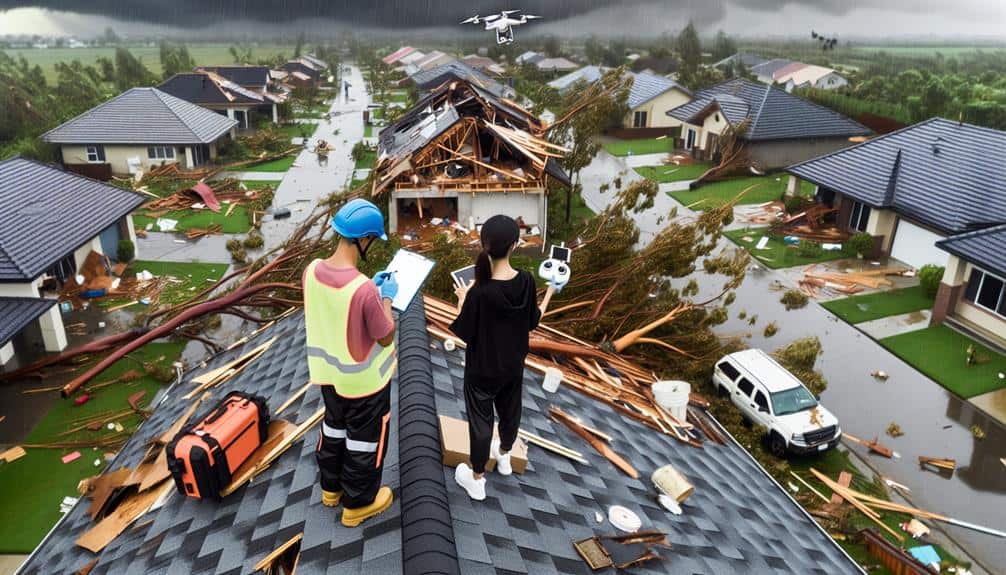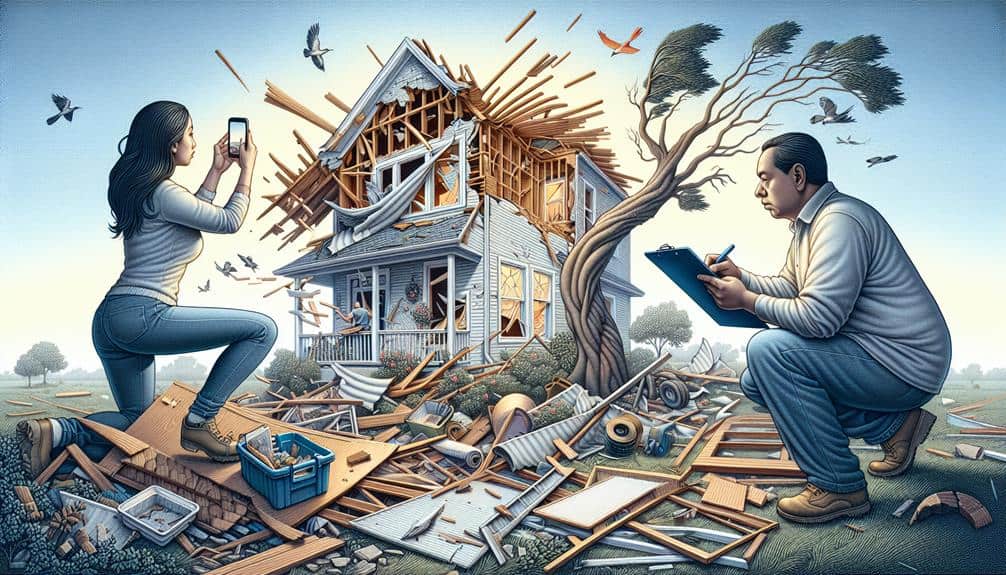When documenting storm aftermath, we'll begin with a safety assessment, identifying risks through structural evaluations and real-time weather information. Equipped with cameras, protective gear, and note-taking materials, we capture extensive viewpoints and concentrate on specific damages using top-notch photos and videos. Comprehensive notes on structural concerns, along with witness accounts, provide significant context. Organizing data into visual, written, and audio forms, and utilizing digital tools for geotagging and timestamping, guarantees meticulous documentation. Let's delve into the crucial elements that improve the precision and effectiveness of storm aftermath documentation.
Key Points
- Conduct hazard evaluation to identify and prioritize risks.
- Capture wide and detailed images of damage using drones and high-quality cameras.
- Document specific damages like broken shingles and debris with thorough notes and photos.
- Collect witness statements using standardized questions for consistency.
Assess Safety Conditions
Assessing the immediate safety conditions is crucial to make certain that our team can proceed without encountering hazards. A prompt and thorough hazard evaluation allows us to pinpoint potential risks that could hinder our progress or jeopardize our lives. We need to systematically evaluate structural damage, fallen power lines, and floodwaters. Using data-driven methods, we can prioritize areas requiring immediate attention and streamline our emergency response.
We begin by conducting visual inspections for obvious dangers, such as unstable structures or exposed electrical wires. Next, we utilize scientific instruments like gas detectors to check for leaks and thermal imaging cameras to identify concealed fire risks. This all-encompassing approach ensures we're not missing any significant threats.
Furthermore, integrating real-time data from weather reports and local emergency management systems helps us anticipate secondary hazards, like aftershocks or additional flooding. By cross-referencing this data, we can refine our emergency response strategies, ensuring they're both proactive and reactive.
In essence, our freedom to operate safely hinges on our ability to meticulously evaluate and mitigate these hazards. By adhering to these protocols, we guarantee a secure environment, allowing us to efficiently document the storm's aftermath without unnecessary risk.
Gather Necessary Tools
To efficiently document the storm's aftermath, we'll need to gather essential tools. High-resolution cameras, protective gear, and robust note-taking supplies are critical for accurate data collection. These tools will guarantee we capture detailed imagery, remain safe, and maintain precise records.
Essential Camera Equipment
Before venturing out to document the storm's aftermath, it's vital we gather high-quality camera equipment to make certain our footage is both precise and professional. Selecting the right tools can greatly enhance our ability to capture detailed imagery and video, guaranteeing we accurately convey the extent of the storm's impact.
Here's a list of essential camera equipment we should consider:
- DSLR or Mirrorless Camera: Provides superior image quality and flexibility with interchangeable lenses.
- Tripod: Ensures stability and reduces motion blur, especially essential in low-light conditions.
- External Microphone: Captures clear audio, minimizing background noise interference.
- Lighting Kit: Compensates for poor natural light, enabling effective use of lighting techniques.
When configuring our camera settings, we should prioritize a high dynamic range to capture both shadow and highlight details. Using manual mode allows us to adjust aperture, shutter speed, and ISO for optimal exposure. Additionally, leveraging lighting techniques such as diffused flash or portable LED lights can help illuminate scenes uniformly, reducing harsh shadows and enhancing detail.
Protective Gear Importance
While our camera equipment is necessary for capturing the storm's aftermath, making sure we've the right protective gear is equally crucial for our safety and effectiveness in the field. Proper safety precautions can significantly decrease the risk of injury in unpredictable post-storm environments.
We should equip ourselves with hard hats, high-visibility vests, and steel-toe boots to protect against falling debris and sharp objects. Additionally, gloves and safety goggles shield us from hazardous materials and airborne particles.
It's essential to remember that gear maintenance is as important as the gear itself. Regularly inspecting our protective gear for wear and tear ensures that it remains dependable and functional. For example, checking hard hats for cracks, verifying the integrity of steel toes in boots, and making sure that high-visibility vests aren't faded or torn can make a substantial difference in our safety.
Furthermore, respiratory protection, such as N95 masks, can be invaluable when dealing with mold, dust, and other airborne contaminants commonly found in storm-damaged areas. By prioritizing our safety and maintaining our protective gear, we can effectively document storm aftermath while minimizing risks, allowing us to operate freely and confidently in challenging conditions.
Note-taking Supplies
When documenting storm aftermath, having reliable note-taking supplies guarantees we can accurately record observations and data in the field. To make sure our documentation is precise and thorough, it's essential to gather the right tools and organize them properly.
Let's explore essential supplies and backup options that support effective note-taking techniques and organization tips.
- Weather-resistant Notebook: A notebook with water-repellent pages ensures our notes remain legible despite harsh weather conditions.
- Automatic Pencils: These offer consistent writing quality and eliminate the need for sharpening, which is impractical in the field.
- Audio Recorder: Capturing sound can be invaluable for later transcription and ensures we don't miss any spoken observations.
- Additional Batteries/Power Bank: Maintaining a power source for our electronic devices prevents disruptions in data gathering.
Take Initial Photos
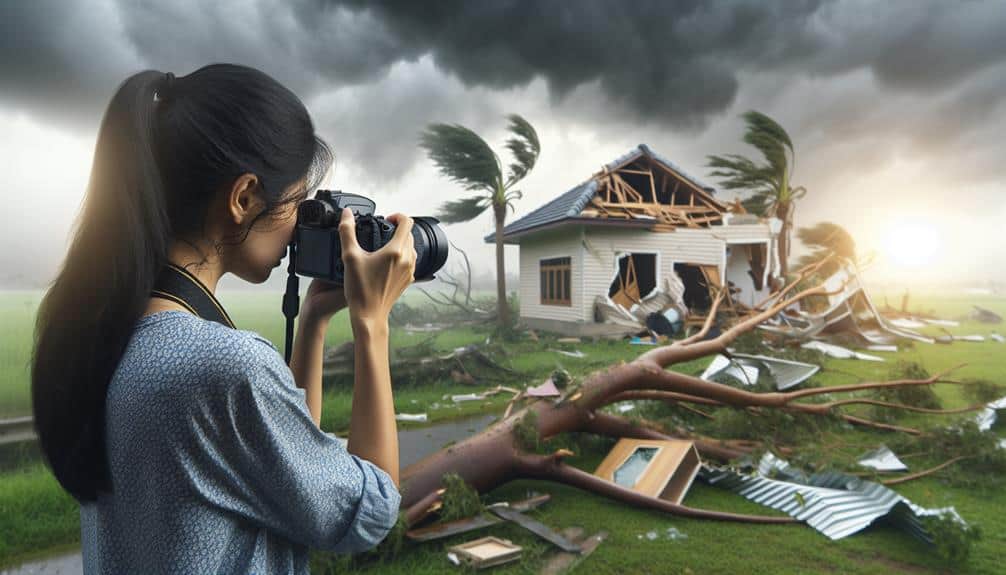
Let's start by capturing diverse perspectives to provide a broad view of the storm's impact.
We'll then focus on documenting specific damaged areas to create a thorough record.
This systematic approach will facilitate accurate damage assessment and data analysis.
Capture Wide Perspectives
Our initial task involves capturing wide-angle photographs to thoroughly document the storm's impact on the landscape. Utilizing drone footage and 360 images allows us to obtain detailed, high-resolution data that's crucial for effective analysis. By starting with broad perspectives, we can establish a contextual framework that aids in understanding the storm's overall severity and geographical impact.
To guarantee we capture the most informative wide-angle perspectives, we should focus on the following:
- Drone footage: Use UAVs (Unmanned Aerial Vehicles) to capture aerial views, providing a bird's-eye perspective that highlights large-scale damage.
- 360 images: Employ 360-degree cameras to create immersive, interactive images that offer a full scope of the affected area.
- Panoramic photos: Take multiple overlapping photos and stitch them together for a sweeping view of the storm's aftermath.
- Geotagging: Assure all images are geotagged to accurately pinpoint the location of each shot, facilitating precise mapping and analysis.
Focus on Damaged Areas
As we move towards documenting specific damaged areas, we'll prioritize taking high-quality photos to capture the fine details of the storm's destruction. High-quality images are essential for a thorough property assessment, allowing us to identify and evaluate the extent of structural damage. By focusing on damaged areas, we can create a detailed visual record that will serve as vital evidence for insurance claims and repair planning.
We'll start by photographing the most severely affected areas first. It's important to capture multiple angles to provide a complete view of the damage. For example, if a roof has been compromised, we should photograph it from different positions, including close-ups that highlight broken shingles, dislodged flashing, or exposed underlayment. This meticulous approach ensures that no detail is overlooked.
Additionally, we should make sure to include any collateral damage in our documentation. This could be anything from shattered windows and damaged siding to uprooted trees and debris. By systematically documenting these elements, we can guarantee that our property assessment is both detailed and accurate. This methodical process empowers us to make informed decisions about repairs, enhancing our ability to restore the property to its pre-storm condition.
Record Detailed Videos
Capturing high-definition videos with stabilized equipment is vital for accurately documenting the storm's impact. We need to guarantee our footage is clear and professional to be effective.
First, let's focus on safety precautions and equipment needs. It's essential to wear proper safety gear, such as helmets and reflective vests, to protect ourselves while recording. Stabilized equipment like gimbals or tripods will help us capture steady footage, reducing motion blur and providing detailed visuals.
Next, we should integrate interview techniques and gather witness accounts. Engaging with local residents and emergency responders can provide valuable context and personal stories.
Here's a checklist to guide our process:
- Safety Gear: Helmets, reflective vests, and gloves.
- Camera Equipment: High-definition cameras, gimbals, and tripods.
- Interview Setup: Portable microphones and consent forms.
- Witness Accounts: Conduct interviews with clear, concise questions.
Note Specific Damages
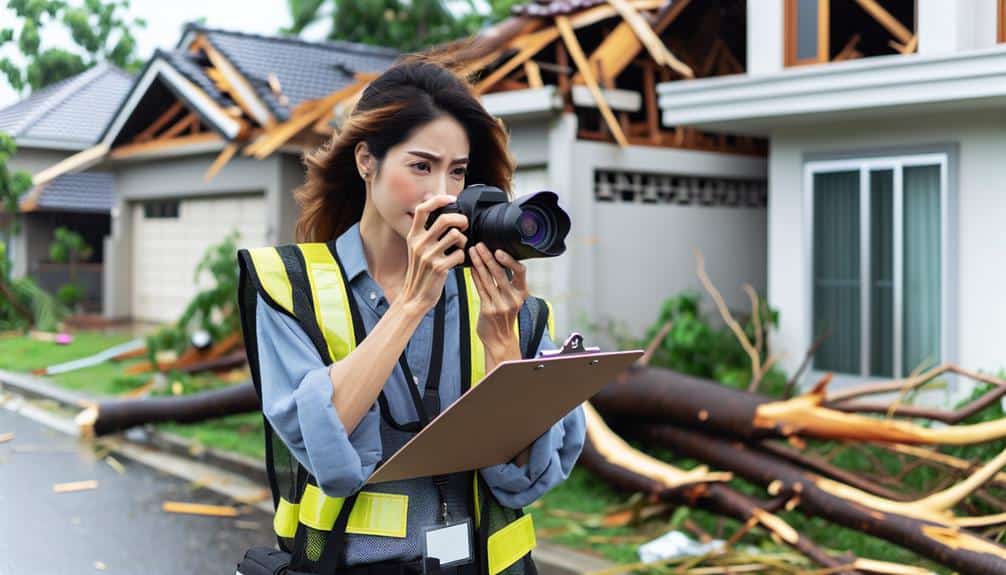
After collecting video footage and interviews, we must systematically record specific damages to provide a detailed analysis of the storm's impact. First, let's concentrate on evaluating structural damage. We should inspect all buildings, noting any compromised foundations, walls, and roofs. Using a checklist, we can make certain that no vital aspect is overlooked. We should look for signs of structural failure, such as cracks, leaning walls, or water infiltration, and photograph these issues for future reference.
Next, documenting inventory becomes essential. We need to catalog all damaged or destroyed items within each affected structure. This includes furniture, electronics, personal belongings, and any other valuable items. By creating a detailed inventory list, we can cross-reference it with pre-storm records to quantify losses accurately. Each item should be tagged with the date, location, and type of damage sustained.
Utilizing geotagging on our photos and videos will enhance the precision of our documentation process. Advanced software can assist in organizing this data, creating thorough reports that support insurance claims and aid in recovery planning. By meticulously noting specific damages, we empower ourselves to take informed actions, ensuring a prompt and effective path to recovery.
Collect Witness Statements
We need to systematically gather witness statements to capture firsthand accounts of the storm's impact and validate our documentation. By employing structured interview techniques, we make sure that the evidence collection process is both thorough and reliable. Witness statements provide critical qualitative data that complements our quantitative damage assessments.
To effectively collect these statements, we should:
- Prepare Questionnaires: Develop standardized questions to maintain consistency across interviews.
- Record Interviews: Use audio or video recording devices to accurately capture the witness's account.
- Verify Identities: Confirm the identity of each witness to ensure the credibility of the statements.
- Note Contextual Details: Document the time, date, and location of each interview to add contextual accuracy.
Utilizing these techniques, we can create a robust repository of firsthand accounts that enrich our overall storm documentation. This meticulous approach to evidence collection not only strengthens the validity of our data but also empowers us to present a detailed narrative of the storm's repercussions.
Organize Documentation
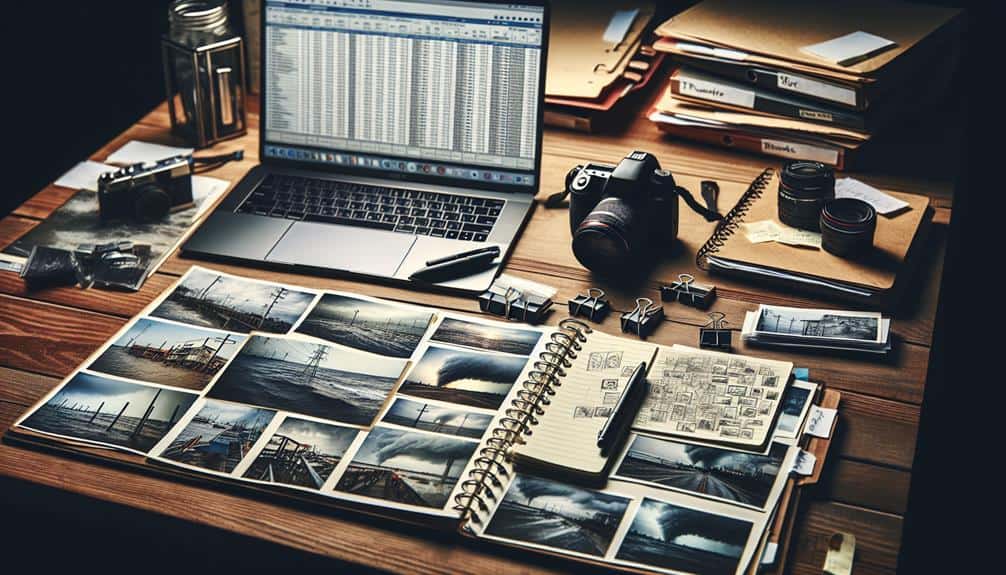
To systematically organize our documentation, we'll categorize all collected data into clearly defined sections for efficient analysis and retrieval.
First, we'll segment our data into visual, written, and audio records. Visual data, captured using our camera gear, will include high-resolution images and videos. We should timestamp each file and tag them with relevant geographic coordinates to facilitate detailed analysis later.
Next, for written data, such as damage reports and safety assessment forms, we'll employ standardized documentation tools. These tools will guarantee consistency and accuracy in recording damage extent, structural integrity, and other critical metrics. We'll use digital formats to enable easy searchability and backup.
For audio data, such as witness statements, we'll convert recordings into transcripts and store them alongside their respective metadata. This practice will improve our ability to cross-reference and verify information.
Frequently Asked Questions
How Can I Back up My Documentation to Prevent Data Loss?
To prevent data loss, we can back up our documentation using cloud storage and an external hard drive. This dual approach guarantees redundancy, providing both immediate access via the cloud and physical security through local storage solutions.
Should I Inform My Insurance Company Before Starting Documentation?
When Jane contacted her insurance company before documenting storm damage, she avoided coverage issues. This example highlights the importance of communication. We should always prioritize contacting our insurance company to guarantee accurate, thorough claims processing.
Are There Specific Apps Recommended for Documenting Storm Damage?
We should compare different apps for storm damage documentation by evaluating their user interfaces, data storage capabilities, and GPS accuracy. Best practices for using apps include taking time-stamped photos, creating detailed notes, and backing up data immediately.
How Can I Safely Store Physical Copies of My Documentation?
Oh, because we all love losing critical documents to damp basements! Let's guarantee secure storage by using moisture-proof containers and create digital backups. This way, we protect our data with redundancy and preserve our freedom from worry.
What Should I Do if I Encounter Hazardous Materials During Documentation?
When we encounter hazardous materials, we should prioritize handling emergencies by evacuating the area immediately. We must follow proper disposal procedures as outlined by environmental regulations to guarantee safety and compliance with legal requirements.
